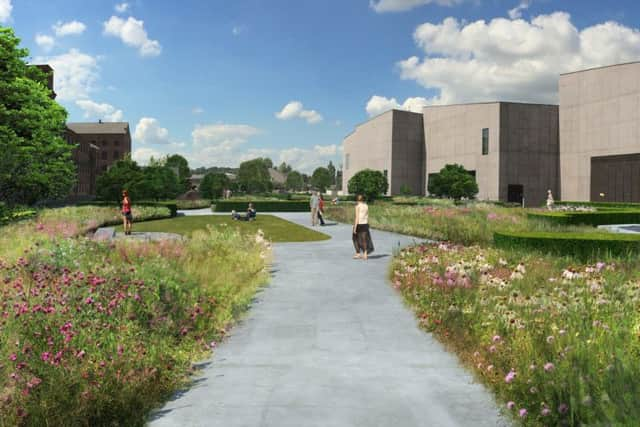Queen's garden designers tackle old industrial plot outside Hepworth Wakefield
Nestled improbably between a weir on the River Calder and the flyover on the A61 to Doncaster, the Hepworth Wakefield is, as one of its new designers observed yesterday, in the middle of nowhere.
But as the art world prepares to converge on West Yorkshire for the country’s biggest-ever celebration of sculpture, a makeover has got under way.
Advertisement
Hide AdAdvertisement
Hide AdThe Hepworth announced yesterday that it had raised more than 80 per cent of the £1.8m it needs to turn the barren grassland that separates it from the old mill building across Tootal Street, into a carefully manicured riverside garden.


Grants from two foundations, on top of a half-million from Arts Council England, mean that work can begin this month on the transformation, with the work expected to be complete in time for the first Yorkshire Sculpture International, a £1.4m summer event aimed at placing Wakefield and Leeds at the centre of today’s sculpture world.
A team from the London consultancy that worked on the Queen’s Jubilee Garden at Windsor has already produced designs for the “meadow-like” landscape, which, said its architect, Shankar Kothapuram, would draw on the region’s “rich horticultural heritage”.
The geometric, concrete-hewn Hepworth building opened in 2011 and has seen 2m visitors through its doors. In 2017 it was named the country’s Art Fund Museum of the Year 2017, and half of its £100,000 winnings have been committed to the garden project.
Advertisement
Hide AdAdvertisement
Hide AdTom Stuart-Smith, the landscape architect in charge of its design, said: “This is one of the very few examples where an institution has the foresight and the vision to say, ‘Look, this is a pretty bad scene outside our front door – we’re going to do something about it’.”
The 4,000-sq metre garden, described as “a modern, romantic response” to a “varied post-industrial location” comprising “robust industrial buildings” and the angular form the gallery itself, is said to be in keeping with the “deeply felt connection with landscape” held by the Wakefield sculptor Barbara Hepworth, after whom the institution is named.
Mr Kothapuram, who is lead designer on the garden, said it would incorporate lawns to lie on and an events space, and would be bordered by a wall to shield it from the A61 and would take its influences from other Yorkshire landscapes at Harewood House and Studley Royal, near Ripon.
It would also draw on the work of the 19th century explorer and conservationist Charles Waterton, who built the world’s first wildfowl and nature reserve, behind a 9ft wall at Walton Hall, on Wakefield’s outskirts, and from the records of the Wakefield and North of England Tulip Society, which was established 1836.
Advertisement
Hide AdAdvertisement
Hide Ad“The gallery was in the middle of nowhere. It’s been crying out for this for a while,” Mr Kothapuram said.
The Hepworth has been raising funds for the garden for two years. Last month, it generated £44,576 in a week, after being selected to take part in the UK’s largest match-funding campaign, which doubled donations made by the public.
The latest grants, totalling £250,000, come from the Foyle Foundation, set up by the London family of booksellers, and the Wolfson Foundation.
Simon Wallis, the gallery’s director, said: “The timing of their awards has put us in an excellent financial position to complete the project this year, allowing Tom Stuart-Smith’s inspiring design to transform the vacant strip of land adjacent to the gallery into a garden for all to enjoy. It will make a huge difference to the setting.”
Advertisement
Hide AdAdvertisement
Hide AdThe summer-long sculpture festival, to be held every three years, will bring together the Hepworth and the Yorkshire Sculpture Park in Wakefield with the Henry Moore Institute and the city Art Gallery in Leeds.